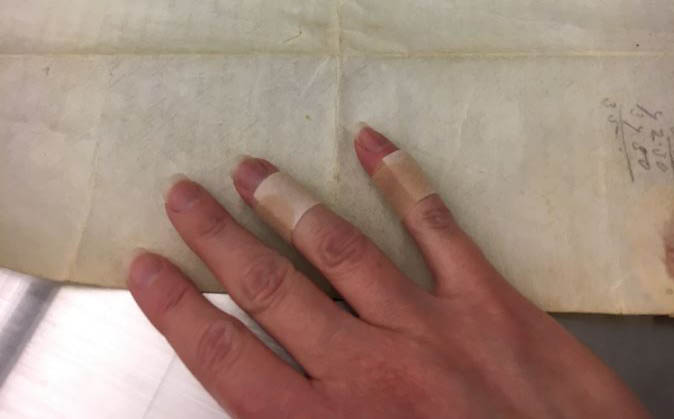This post was written by Amy Sullivan, Preservation Officer for George Mason University Libraries. You can follow Amy’s adventures in preservation on Instagram @gmupreservation. SCRC sent items from Randolph H. Lytton Historical Virginia collection to be de-framed by Amy and her student, and she noted this document made of parchment that was covered in *GASP* scotch tape.
Pressure sensitive tape is the bane of archival collections. It’s never good for preservation, but in this particular case it’s bad for a new reason: it’s on parchment. (A quick primer: parchment is hide that has been prepared by paring and stretching under tension as it dries.) Unlike paper with similar problems, you can’t heat the adhesive (in this case, tape) to make it pliable – heat can shrink and even split the parchment – or use anything wet, like a solvent (as moisture introduces the possibility of warping and stretching). this means it’s time for some good old fashioned mechanical reversal. Yep, that’s right, time and patience and a microspatula are all you need. (Side note 1: always stop when the friction caused by stabilizing your spatula hand with some fingers against your work surface start to bleed. Preferably before it ends up on the item under treatment. Side note 2: transparent tape means you’ll be working almost 100% by feel to know where the tape is and when you’ve removed it all.) Below are some pictures of this process. Enjoy!

The document in question – a contract on parchment.

The parchment attached to board by tape.

The board without the parchment. Note all the tape used to attach it to the parchment.

Tape attached to the parchment. An archivist’s and preserver’s nightmare!

Tape attached to the parchment.

The microspatula a work: a mighty tool!

The work is never done, and Amy’s hands take no prisoners! (Make sure not to bleed on your documents!)
Follow Special Collections Research Center on Social Media at our Facebook, Instagram, and Twitter accounts. To search the collections held at Special Collections Research Center, go to our website and browse the finding aids by subject or title. You may also e-mail us at speccoll@gmu.edu or call 703-993-2220 if you would like to schedule an appointment, request materials, or if you have questions. Appointments are not necessary to request and view collections.

